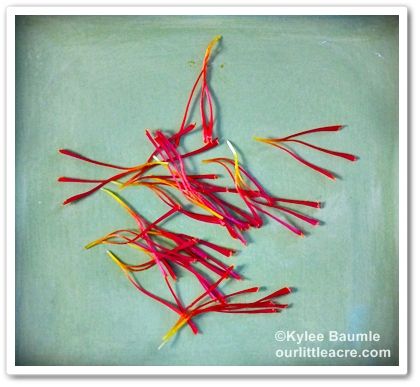While I was traveling in Arizona over the weekend, the saffron crocus (Crocus sativus) burst into bloom back home here in Ohio. I planted the corms in the fall of 2010, and only got foliage last year. No blooms. But they were busily reproducing as they grew. I started with 10 corms purchased from Easy to Grow Bulbs and I can count foliage from 31 of them now, although one corm can produce more than one bloom.
This morning, I was astounded at what I saw as I rounded the corner of the conservatory and saw the brilliant, streaked petals with red stigmas and bright yellow stamens.
Those red stigmas - three per bloom - are the source of the spice, saffron. As you can imagine, they must be harvested by hand, contributing to their notoriety as the most expensive spice in the world. They also must be harvested shortly after blooming because the heat of the sun wilts the blooms.
It takes 75,000 blossoms to produce just a pound of dried saffron threads which sell for $70 per ounce WHOLESALE. Iran is responsible for more than 90% of the world's saffron production.
Saffron corms aestivate in the spring. No, I didn't know that word before today; I had to look it up. It means the act of a flower forming within a flower bud. In the case of the saffron crocus, this takes place in spring, but the flower buds don't emerge and open until fall, typically in October. It can be grown in Zones 6-9, but does well for me in Zone 5b.
The flavor of saffron is said to be an acquired taste, being sweet and bitter at the same time. It is a popular addition to Indian dishes and is also used in Spanish paella. Though it's expensive, it's an intense spice, so a little goes a long way. Saffron is the spice that gives paella and other dishes that golden yellow color.
I grow saffron crocus because they're unique and beautiful, but since it doesn't take much when used in cooking to impart its flavor, I think I'll have enough to make a rice dish that features saffron. So far this fall, my saffron harvest consists of the stigmas from 17 blooms, which amounts to 51 threads. They are drying in my kitchen now.
Dried saffron should be stored in an airtight container in a cool location. In Pennsylvania Dutch country near Lancaster, special containers made of wood for storing saffron are made, and these have become quite the collector's item. Some vintage saffron boxes have sold for tens of thousands of dollars.




















 "Bejeweled"
"Bejeweled"



4 comments:
Beautiful! I just received my saffron crocuses but haven't planted them yet. I can't wait to try this! Do you have yours incorporated into the landscape? I initially thought to do that, but a friend said her saffron was particular about any competition. Any thoughts? I'm so excited to hear about your rice dish--yum!
Great information, Kylee. I have been trying to grow some but they didn't pop up this year. I checked and the bulbs are still viable so hopefully next season.
Julie ~ Mine are just planted next to this lava rock in a small bed on the southeast side of the conservatory. Nothing is very near to them, but I read an article by someone who has grown them for years and they grow Portulaca over top of them during summer. They pull those out once the foliage breaks through the surface in the fall. So apparently you can grow other things on top of them. Good luck with yours, Julie!
Stevie ~ Mine didn't do anything the fall I planted them, and very little last year (only some foliage). So I was super excited to see these yesterday! I know it's a year away, but I'm anxious to hear how yours do next fall!
Beautiful and useful in the kitchen too!
Have a wonderful day!
Lea
Lea's Menagerie
Post a Comment